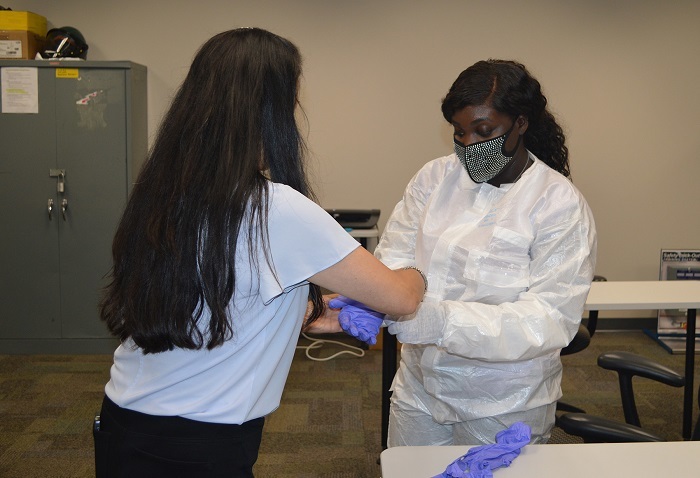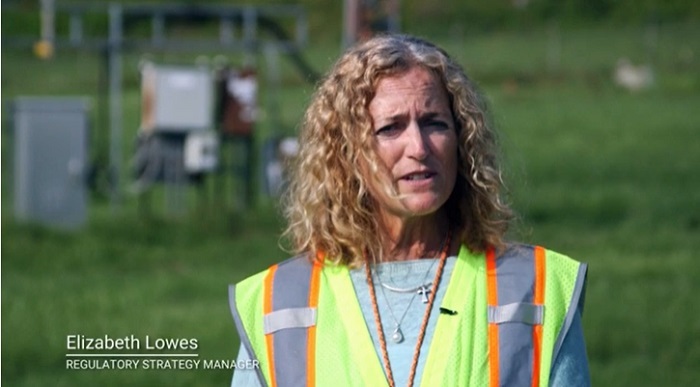 Elizabeth Lowes, a regulatory strategy manager with CH2M HILL BWXT West Valley, is shown discussing environmental monitoring for the planned Main Plant Process Building demolition at EM’s West Valley Demonstration Project in a new video. “We will be carefully monitoring the environment, and that includes groundwater, surface water, and air, and we also sample flora and fauna in the near-site area,” Lowes says in the video.
WEST VALLEY, N.Y. – EM’s West Valley Demonstration Project (WVDP) and cleanup contractor CH2M HILL BWXT West Valley (CHBWV) have released two videos related to the planned demolition of the Main Plant Process Building featuring site subject-matter experts with more than 130 years of combined experience in nuclear decommissioning and environmental cleanup.
One of the videos, on environmental monitoring, details the site’s innovative monitoring system that verifies protective measures and safeguards in place continue to be protective of employees, the public, and the environment.
“The removal and disposal of the Main Plant Process Building is the primary task we have left to do under our contract scope of work,” CHBWV President John Rendall said. “More than 98 percent of the contamination has been removed from the building, and we have monitoring controls in place to ensure safety and compliance.”
In the video, the experts discuss how the site’s robust environmental monitoring system provides notifications when operating conditions change, allowing workers to adjust operations based on data collected. The system also confirms that controls are functioning as designed.
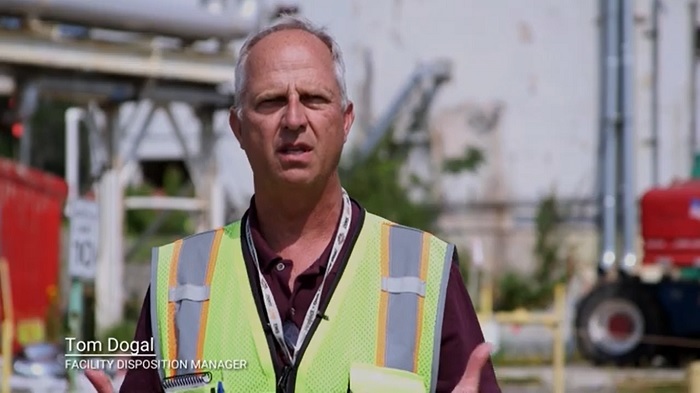 Tom Dogal, facility disposition manager with CH2M HILL BWXT West Valley, is pictured discussing safeguards for the planned demolition of the Main Plant Process Building in a new video available from the West Valley Demonstration Project. The video focuses on safeguards instituted for EM’s planned demolition of the building.
In the other video, on the Main Plant demolition, employees describe the site’s safe and compliant approach to deconstruct the facility.
“This is an engineered approach designed to safely deconstruct this facility at a deliberate rate and sequence while maintaining the building’s structural integrity,” CHBWV Deputy General Manager Kelly Wooley said.
Wooley said EM’s strategy for the Main Plant project incorporates best practices and lessons learned from the WVDP and the greater DOE complex.
“In addition to the use of deliberately planned and sequenced demolition, this approach includes the implementation of robust work controls and the use of specialized tools and techniques to safely deconstruct the building,” Wooley said.
EM plans to begin demolishing the Main Plant later this year. Over the past two decades, workers have been preparing to ensure the demolition is conducted in a manner protective of human health and the surrounding environment. The teardown is expected to take more than 30 months to complete.
-Contributor: Joseph Pillittere
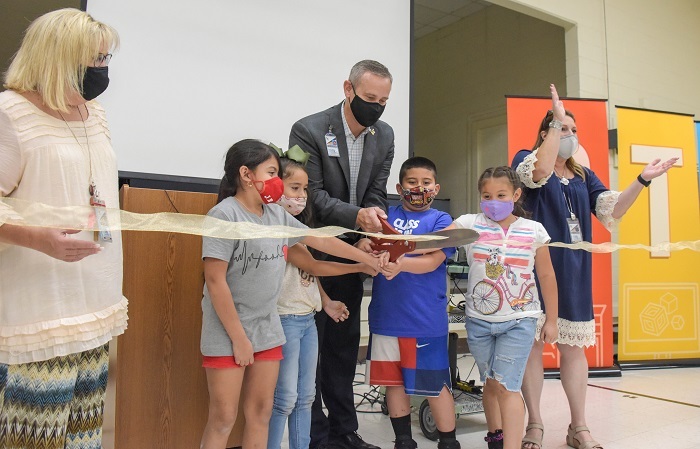 Hobbs Municipal Schools Superintendent Gene Strickland, center, with Sanger Elementary Principal Kelly Inman, far left, and Jefferson Elementary Principal Pam Randall, far right, join students to cut the ribbon on a new Cal Ripken, Sr. Foundation STEM Center mobile laboratory at Jefferson Elementary.
CARLSBAD, N.M. – EM’s main contractor at the Waste Isolation Pilot Plant (WIPP) helped fund two centers for an area school district where students can stretch their imaginations while honing their science, technology, engineering, and math (STEM) skills by exploring electric circuit boards, tiny robots, and other unique gadgets.
Each Cal Ripken, Sr. Foundation STEM Center mobile laboratory comes equipped with innovative classroom kits full of STEM toys designed to inspire lifelong interest in STEM. Students can learn how to build a circuit to motor fans, power lights, or even charge phones. The Evo Ozobots are electronic circuit robots about the size of a coffee pod that follow hand-drawn or computer-printed color diagrams to encourage students to code creatively. The centers are also outfitted with 3D printers and printer supplies.
Nuclear Waste Partnership (NWP) was one of three major employers in southeastern New Mexico that helped fund the STEM centers at Jefferson and Sanger elementary schools for Hobbs Municipal Schools earlier this year. The two other employers are oil-producing companies Devon Energy and EOG Resources.
“We want the children in our state, and especially in our region, to have access to the best learning tools available for STEM education,” said Sean Dunagan, NWP president and project manager. “Centers like these foster a passion for science and math and we are proud to contribute to opening the STEM centers at Jefferson and Sanger elementary schools.”
 Pictured at Jefferson Elementary School, from left, are Khushroo Ghadiali with Nuclear Waste Partnership, Shannon Johnson with Devon Energy, Pam Randall with Jefferson Elementary, Gene Strickland with Hobbs Municipal Schools, Taylor Smith with EOG Resources, and Joe Rosso with the Cal Ripken Sr, Foundation. Employees from the foundation were at the school to provided training for a new Cal Ripken, Sr. Foundation STEM Center mobile laboratory.
 Jefferson Elementary School educators practice with the ROK Blocks module, which allows children to build using their imagination and creativity while they learn about the design and engineering cycle to prototype, improve, and iterate their designs.
The foundation provides hands-on training to educators to learn how to use the tools. Marisol Forrister, a fourth-grade teacher at Jefferson Elementary School, received the training.
“Thank you all so much. We are super excited and grateful. The training was awesome. My students are ready,” she said.
During the training, the teachers and staff from Jefferson learned how students can take part in real world problem-solving at the STEM centers. For example, they explore coding and sequencing, which are foundational to writing a computer program or building a website. They also learn about electrical work, using electronic building blocks connected by magnets to create circuits that use buttons, switches, motors, and other elements.
“STEM centers like these inspire, educate, and spark lifelong success in STEM fields,” said Khushroo Ghadiali, NWP community and governmental affairs coordinator, who assisted in organizing the training and opening for the STEM centers. “NWP prioritizes investing in education in the surrounding area in the hope that one day the individuals we supported as children are encouraged to join a STEM related field as an adult, or even better a STEM related field with WIPP.”
-Contributor: Shannon Carr
 From left, Jonathan, Shawn, and Sharetta McCullough, employees with ML Builders, a Savannah River Nuclear Solutions (SRNS) protégé company, describe their services to SRNS buyer Vera Curtis. This photo was taken prior to the COVID-19 pandemic.
AIKEN, S.C. – EM’s cleanup contractor at the Savannah River Site (SRS) has awarded subcontracts valued at more than $1 billion to small and diverse businesses locally and nationally in the past four years.
“Our buyers work tirelessly to find opportunities for small and diverse suppliers, which is reflected in our committing nearly 80 percent of all procurement dollars to these companies,” said Sean Alford, Savannah River Nuclear Solutions (SRNS) chief administrative officer.
Since the beginning of the SRNS prime contract at SRS in 2008, the SRNS Small Business Program has received 17 awards for its work, with 15 presented in the last three years.
Among the personnel working to build on SRNS small business achievements is Small Business Liaison Officer J. Alex Agyemang, who was appointed to the National Minority Supplier Development Council’s Supplier Diversity Advisory Committee (SDAC) in July. The standing committee provides expertise and advice on supplier diversity and development to the council’s board of directors.
“The SDAC addresses some of the most plaguing issues in the industry, such as talent management, return on investment, and supplier development business needs,” Agyemang said.
In addition, Jay Johnson, SRNS senior director of contracts, was appointed to the board of directors for the Carolinas-Virginia Minority Supplier Development Council.
Alford said SRNS’s posture on supplier development has been unwavering.
“We have always been committed to our small business partners,” Alford said. “It’s a part of our culture.”
Among the small businesses that SRNS subcontracts with is CTI and Associates, an SRNS mentor-protégé company that provides demolition, remediation, and environmental services. To date, the company has demolished nine buildings at SRS, helping reduce EM’s footprint while preparing the site for new missions.
“At Savannah River Nuclear Solutions, we have made supplier development a value we pursue daily,” said Fred Freeman, SRNS supply chain procurement director. “We partner with our suppliers to ensure the success of our missions, while helping these same suppliers meet their goals and objectives. This is one of the primary reasons we have such a strong, positive impact within the small business community.”
-Contributor: DT Townsend
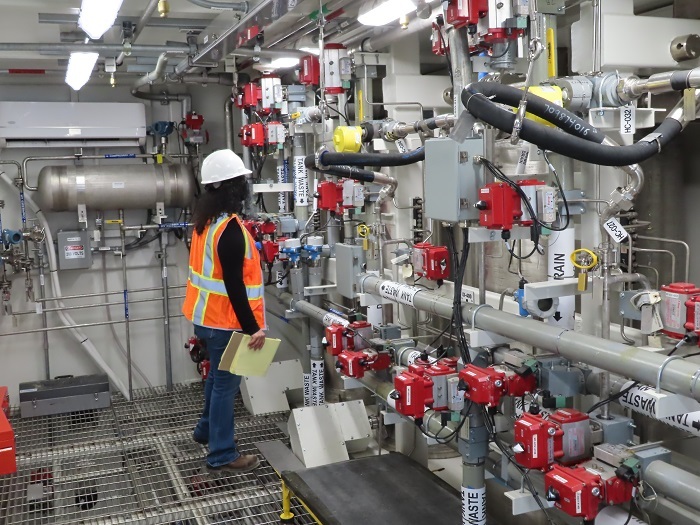 Nitya Chandran, a facility engineer with the Washington State Department of Ecology, inspects the Tank-Side Cesium Removal connections as a part of the Direct-Feed Low-Activity Waste system at the Hanford Site. DOE recently awarded four financial assistance grants, including one to the Washington State Department of Ecology to continue its regulatory activities under the Comprehensive Environmental Response, Compensation and Liability Act.
RICHLAND, Wash. – DOE awarded four financial assistance grants, totaling approximately $33.5 million, to Oregon and Washington state last week. The non-competitive grants support environmental response regulatory activities, emergency preparedness, and public information programs related to the Hanford Site.
DOE awarded Washington state three grants totaling approximately $29.1 million for regulatory oversight and emergency preparedness for the next five years, from Oct. 1, 2021 to Sept. 30, 2026. The funding supports the following activities:
- The Washington State Department of Ecology was awarded approximately $19.1 million to continue its regulatory activities under the Comprehensive Environmental Response, Compensation and Liability Act. This includes regulating chemical and hazardous waste cleanup under the Resource Conservation and Recovery Act and reviewing Hanford cleanup plans for compliance with state laws and regulations.
- The Washington State Department of Health was awarded approximately $5.2 million to continue to provide oversight of the Department’s radiation monitoring programs. This includes independently collecting and analyzing samples to verify the quality of the Department’s programs.
- The Washington State Military Department was awarded approximately $4.8 million to continue emergency preparedness planning with local counties near the Hanford Site, as well as other state agencies. The allocation also funds planning for waste transportation along state highways.
Oregon was awarded one grant totaling approximately $4.4 million for technical review of Hanford and public information activities for the next five years, from Oct. 1, 2021 to Sept. 30, 2026. This includes administering the Oregon Hanford Cleanup Board that discusses Hanford cleanup. The award also funds emergency preparedness planning related to Hanford.
All four grants are for fiscal years 2022 through 2026.
|


